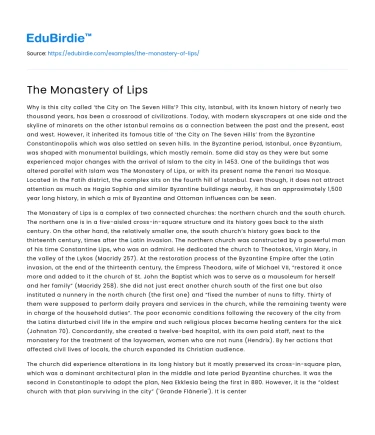Why is this city called ‘the City on The Seven Hills’? This city, Istanbul, with its known history of nearly two thousand years, has been a crossroad of civilizations. Today, with modern skyscrapers at one side and the skyline of minarets on the other Istanbul remains as a connection between the past and the present, east and west. However, it inherited its famous title of ‘the City on The Seven Hills’ from the Byzantine Constantinopolis which was also settled on seven hills. In the Byzantine period, Istanbul, once Byzantium, was shaped with monumental buildings, which mostly remain. Some did stay as they were but some experienced major changes with the arrival of Islam to the city in 1453. One of the buildings that was altered parallel with Islam was The Monastery of Lips, or with its present name the Fenari Isa Mosque. Located in the Fatih district, the complex sits on the fourth hill of Istanbul. Even though, it does not attract attention as much as Hagia Sophia and similar Byzantine buildings nearby, it has an approximately 1,500 year long history, in which a mix of Byzantine and Ottoman influences can be seen.
The Monastery of Lips is a complex of two connected churches: the northern church and the south church. The northern one is in a five-aisled cross-in-square structure and its history goes back to the sixth century. On the other hand, the relatively smaller one, the south church’s history goes back to the thirteenth century, times after the Latin invasion. The northern church was constructed by a powerful man of his time Constantine Lips, who was an admiral. He dedicated the church to Theotokos, Virgin Mary, in the valley of the Lykos (Macridy 257). At the restoration process of the Byzantine Empire after the Latin invasion, at the end of the thirteenth century, the Empress Theodora, wife of Michael VII, “restored it once more and added to it the church of St. John the Baptist which was to serve as a mausoleum for herself and her family” (Macridy 258). She did not just erect another church south of the first one but also instituted a nunnery in the north church (the first one) and “fixed the number of nuns to fifty. Thirty of them were supposed to perform daily prayers and services in the church, while the remaining twenty were in charge of the household duties”. The poor economic conditions following the recovery of the city from the Latins disturbed civil life in the empire and such religious places became healing centers for the sick (Johnston 70). Concordantly, she created a twelve-bed hospital, with its own paid staff, next to the monastery for the treatment of the laywomen, women who are not nuns (Hendrix). By her actions that affected civil lives of locals, the church expanded its Christian audience.
Save your time!
We can take care of your essay
- Proper editing and formatting
- Free revision, title page, and bibliography
- Flexible prices and money-back guarantee
The church did experience alterations in its long history but it mostly preserved its cross-in-square plan, which was a dominant architectural plan in the middle and late period Byzantine churches. It was the second in Constantinople to adopt the plan, Nea Ekklesia being the first in 880. However, it is the “oldest church with that plan surviving in the city” ('Grande Flânerie'). It is centered in a square naos which is divided into nine bays by four columns. The central bay is covered by a dome and “The naos culminates in the east by a tripartite bema and in the west by a three-bay narthex” ('Grande Flânerie'). The four rectangular bays connected to the naos are barrel vaults, an element formed by the extension of a single curve along a given distance, and are the arms of the ‘cross’, that is is inscribed within the square naos. These barrel vaults were especially common in Roman architecture which influenced the Byzantines: they were, for instance, used to replace the Cloaca Maxima with a system of underground sewers.
The influence of Byzantines is also seen in the decorations of the exteriors of the two churches. As Alexander Van Millingen, a Robert College professor in history, emphasized in his book, “The exterior of the two churches is very plain. On the west are shallow wall arcades in one order, on the south similar arcades in two” (132). While the north church was being constructed, the Byzantine architecture was at its pinnacle under the rule of the Macedonian dynasty. That is why, one can expect a lavish exterior; however, it was quite the opposite. In the early tenth century, the exteriors of the churches had the impression of “having been left to their own devices”; they were just the result of the need to cover the rich interiors (Johnson). In short, the strong political and social stability mostly effected the interior. The south church, also, didn’t have a meticulously decorated exterior, even though it was constructed later. Most historians link its exterior simplicity with the economic instability of the empire at the thirteenth century in the aftermath of the Latin invasion (Tuncer).






 Stuck on your essay?
Stuck on your essay?

